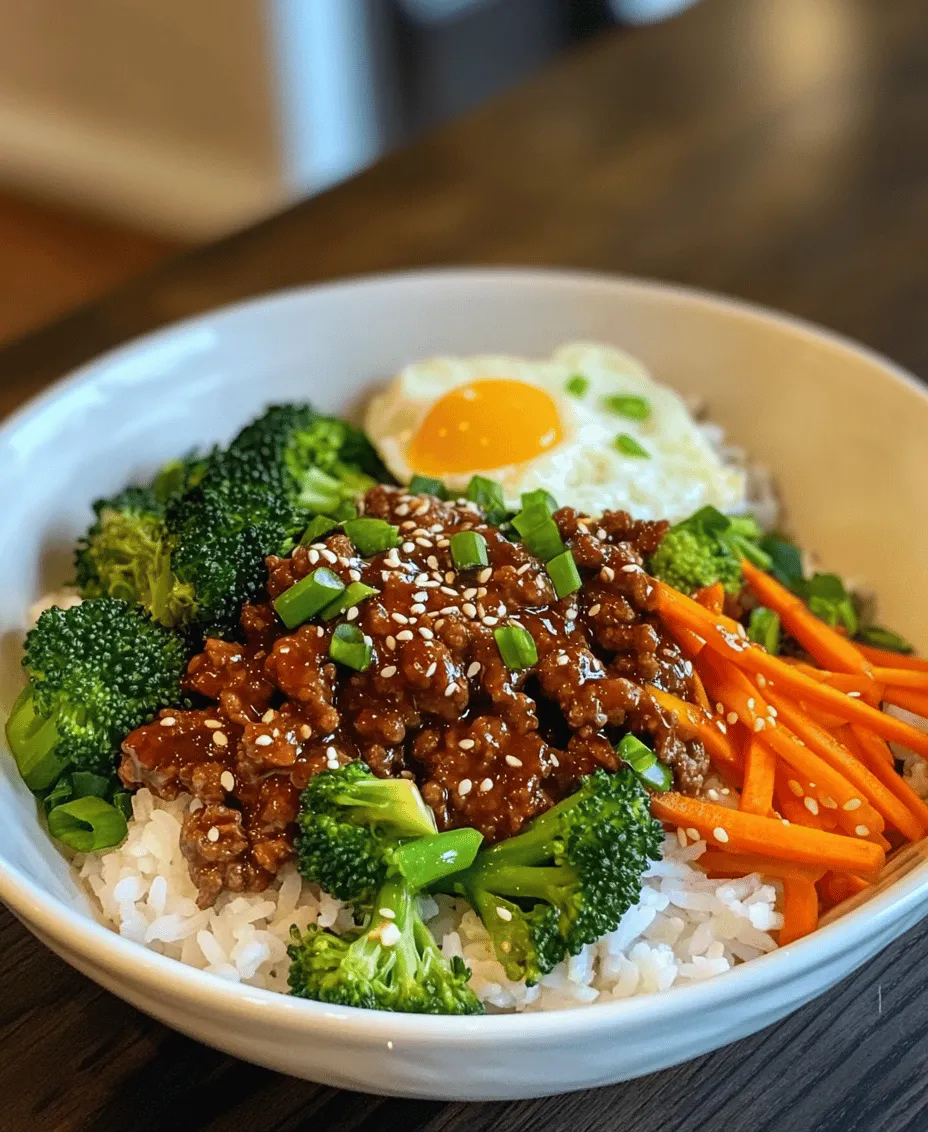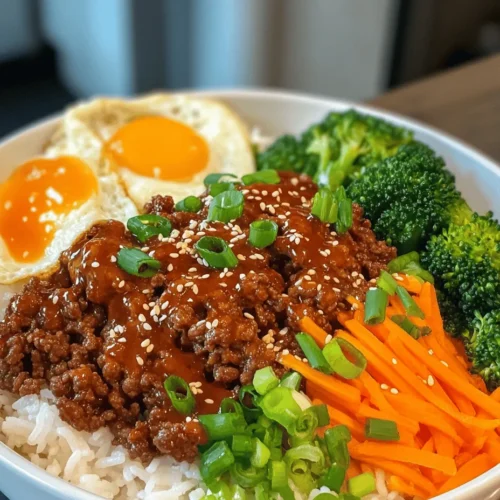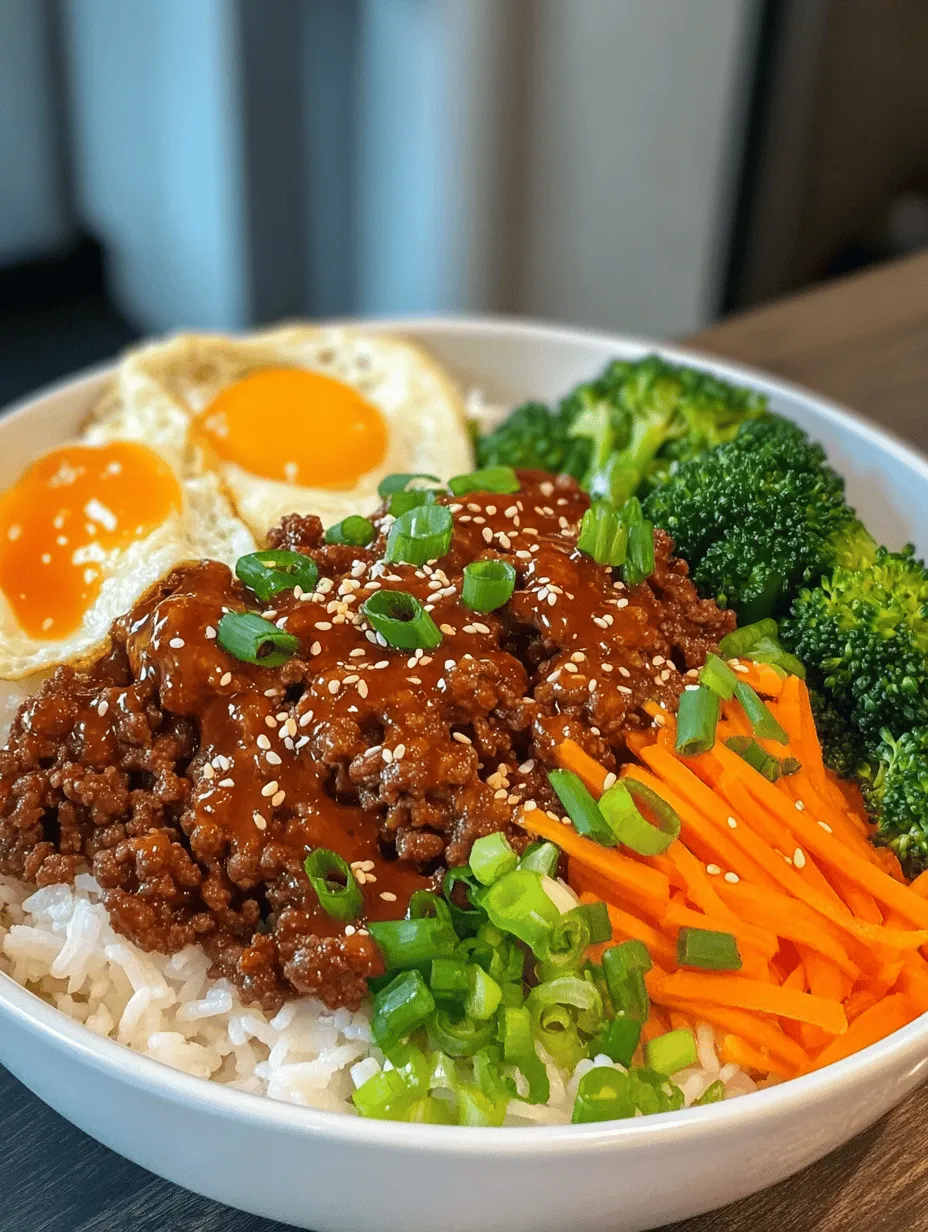Introduction
Korean cuisine has captivated food enthusiasts worldwide with its rich flavors, vibrant colors, and diverse textures. The global rise of Korean food can be attributed to its unique blend of savory, sweet, spicy, and umami elements, making it incredibly appealing to a wide range of palates. One dish that perfectly encapsulates these characteristics is the Spicy Korean Beef Bowl, a meal that has quickly become a favorite for many home cooks. This delectable dish is not only full of flavor but is also incredibly easy to prepare, making it an ideal weeknight dinner option.
The Spicy Korean Beef Bowl is a harmonious fusion of tender, seasoned ground beef, fresh vegetables, and a variety of toppings that enhance its complexity. The balance of flavors and textures makes this dish a culinary delight that can be enjoyed by both seasoned chefs and novice cooks alike. Whether you’re craving something hearty or looking to impress guests with a vibrant meal, this bowl will not disappoint.
In this article, we will delve into the essential ingredients that give the Spicy Korean Beef Bowl its signature flavor, as well as the preparation and cooking techniques that promise a delicious outcome. Let’s embark on this gastronomic adventure!
Understanding the Ingredients
To create a flavorful Spicy Korean Beef Bowl, it is crucial to understand the key ingredients that contribute to its unique taste profile. Each component plays a vital role in enhancing the overall dish, ensuring a delightful culinary experience.
Ground Beef
The foundation of the Spicy Korean Beef Bowl is lean ground beef. Choosing the right cut is essential for achieving the perfect texture and flavor. Ground beef is not only economical but also quick to cook, making it a popular choice for weeknight meals. Opt for lean ground beef (around 80% lean) to ensure a juicy and flavorful result without excessive grease. The meat absorbs the bold flavors of the marinade, resulting in a dish that is both satisfying and delicious.
Gochujang
No Spicy Korean Beef Bowl would be complete without gochujang, a traditional Korean chili paste that is a staple in Korean cooking. This fermented paste is made from red chili powder, glutinous rice, fermented soybeans, and salt, resulting in a rich, spicy, and slightly sweet flavor. Gochujang not only adds heat to the dish but also contributes depth and complexity, elevating the overall taste. Its unique flavor profile makes it a must-have ingredient, and it can be found in most grocery stores or specialty Asian markets.
Sesame Oil
Sesame oil is another essential ingredient that brings authenticity to the Spicy Korean Beef Bowl. This oil is pressed from toasted sesame seeds, imparting a distinct nutty flavor that enhances the dish. Adding a drizzle of sesame oil provides a fragrant aroma and complements the spiciness of the gochujang. In addition to its delightful taste, sesame oil is rich in antioxidants and healthy fats, making it a nutritious choice for cooking.
Honey or Brown Sugar
To achieve a well-rounded flavor in the Spicy Korean Beef Bowl, a touch of sweetness is necessary. Honey or brown sugar balances the heat from the gochujang and rounds out the dish. The sweetness helps to mellow the spiciness, creating a harmonious blend of flavors. Using honey adds a natural sweetness, while brown sugar provides a caramel-like depth. Either option will work beautifully in this recipe.
Fresh Vegetables
A key aspect of the Spicy Korean Beef Bowl is the incorporation of fresh vegetables. Broccoli, carrots, and green onions not only add vibrant color and crunch but also contribute essential nutrients. Broccoli is rich in vitamins C and K, while carrots provide beta-carotene, supporting overall health. Green onions offer a mild onion flavor that enhances the dish without overpowering it. The combination of fresh vegetables not only elevates the nutritional value but also adds texture and freshness to each bite.
Optional Toppings
To take your Spicy Korean Beef Bowl to the next level, consider adding optional toppings that provide additional flavor and texture. A fried egg on top creates a creamy richness that perfectly complements the savory beef. Seaweed adds a salty crunch, while kimchi introduces a tangy, fermented kick. These toppings are not only delicious but also add visual appeal, making your bowl Instagram-worthy.
Preparation and Cooking Techniques
Now that we’ve explored the ingredients, it’s time to dive into the preparation and cooking techniques that will help you create a mouthwatering Spicy Korean Beef Bowl.
Mise en Place
Before you begin cooking, it’s essential to practice mise en place, which means “everything in its place.” Gathering and preparing all your ingredients beforehand ensures a smooth cooking process. Chop your vegetables, measure out your seasonings, and have your ground beef ready to go. This method not only saves time but also reduces the chances of forgetting an ingredient during the cooking process.
Cooking the Beef Mixture
Start by heating a large skillet or wok over medium-high heat. Add a drizzle of sesame oil to the pan, allowing it to heat up before adding your ground beef. The key to a flavorful beef mixture is to break it apart as it cooks, allowing it to brown evenly. This step is crucial for developing a rich flavor, so be patient and let the beef caramelize slightly before stirring too often.
Sautéing Garlic and Ginger
For the best flavor, don’t forget to sauté garlic and ginger in the same skillet before adding the ground beef. Begin by adding minced garlic and grated ginger to the hot oil, allowing them to sauté for about 30 seconds until fragrant. This step infuses the oil with aromatic flavors, which will permeate the beef as it cooks. Be cautious not to burn the garlic, as it can turn bitter quickly.
Browning the Beef
Once your garlic and ginger are fragrant, add the ground beef to the skillet. Use a spatula to break up the meat into smaller pieces as it cooks. Allow it to brown evenly, which will take about 5-7 minutes. The browning process is essential for flavor development; the more caramelization, the richer the taste. Stir occasionally to ensure even cooking, and drain any excess grease if necessary.
Steaming Vegetables
While the beef is cooking, it’s time to prepare your vegetables. You can opt for steaming them to retain their nutrients and vibrant colors. If you don’t have a steamer, you can easily use a microwave. Place your broccoli and sliced carrots in a microwave-safe bowl with a splash of water, cover, and steam for 3-4 minutes until tender yet crisp. This quick cooking method ensures the vegetables maintain their freshness and add a delightful crunch to your bowl.
Assembly of the Bowl
As you finish cooking the beef and steaming the vegetables, it’s time to assemble your Spicy Korean Beef Bowl. Start by placing a generous scoop of cooked rice at the bottom of a bowl. The rice acts as a perfect base, soaking up the delicious flavors from the beef and sauce. Next, top the rice with a portion of the spicy beef mixture, followed by the steamed vegetables. Finish it off with your choice of optional toppings, such as a fried egg, seaweed strips, and a side of kimchi for an added kick.
Stay tuned for the next part of this article, where we will provide detailed instructions on how to create the perfect sauce, tips for customizing your bowl, and answers to common questions about this delightful dish.

Importance of Layering Flavors
When constructing your Spicy Korean Beef Bowl, the importance of layering flavors cannot be overstated. Starting with a solid base, such as steamed rice, sets the stage for the dish’s overall taste profile. The rice absorbs the flavors from the beef, sauces, and vegetables, creating a harmonious balance of taste in every bite. Here’s how to build your bowl for maximum flavor:
1. Base Layer: Begin with a generous scoop of steamed white or brown rice. The rice will serve as the foundation of your bowl, offering a neutral canvas that absorbs the spices and sauces.
2. Protein Layer: Next, add your spicy marinated beef. The ground beef, infused with garlic, ginger, and gochujang, should be evenly distributed over the rice, allowing the flavors to meld.
3. Vegetable Layer: Top the beef with a colorful array of sautéed or fresh vegetables. Options like julienned carrots, sliced cucumbers, and bell peppers add crunch and freshness, balancing the richness of the beef.
4. Sauce Layer: Drizzle additional sauce or a spicy mayo over the top for added moisture and a flavor boost. This step enhances the overall taste while allowing each bite to offer a distinct combination of ingredients.
5. Garnish Layer: Finally, finish your bowl with garnishes such as chopped green onions, sesame seeds, or a sprinkle of nori. These not only elevate the visual appeal but also add layers of texture and flavor.
By following this layering method, you create a well-balanced dish that excites the palate and satisfies hunger.
Presentation Tips for a Visually Appealing Bowl
Visual appeal plays a crucial role in the enjoyment of food, especially in a dish like the Spicy Korean Beef Bowl. Here are some tips to make your bowl look as good as it tastes:
– Color Contrast: Use a variety of colorful vegetables. The vibrant greens of spinach or bok choy, the bright orange of carrots, and the rich red of gochujang create an inviting and appetizing presentation.
– Layering Technique: Arrange your ingredients in a way that showcases each component. Avoid mixing everything together; instead, keep the rice at the bottom, followed by the beef and then the vegetables nicely arranged on top.
– Garnishing: Don’t underestimate the power of garnishes. A sprinkle of sesame seeds or finely chopped herbs like cilantro adds a professional touch. Consider adding a wedge of lime or lemon for a pop of color and a hint of acidity.
– Serving Dish: Choose a bowl that complements your dish. A shallow, wide bowl can help present the ingredients beautifully, whereas a deep bowl can give a more rustic feel. The right dish enhances the overall dining experience.
Portion Sizes and Balancing Protein, Carbs, and Vegetables
When preparing the Spicy Korean Beef Bowl, understanding portion sizes is key to achieving a well-balanced meal. A typical serving should include:
– Protein: Aim for about 3 to 4 ounces of cooked ground beef per serving. This amount provides a hearty dose of protein, essential for muscle repair and overall health.
– Carbohydrates: Use about 1 cup of cooked rice, which will serve as your primary carbohydrate source, giving you energy for the day. Brown rice adds more fiber, while white rice offers a softer texture.
– Vegetables: Incorporate at least one cup of assorted vegetables. This not only adds color and texture but also ensures you are getting vitamins, minerals, and fiber essential for digestion and overall well-being.
Balancing these components ensures that your meal is not only satisfying but also nutritious, making it easier to fit into various dietary plans.
Nutritional Benefits of the Spicy Korean Beef Bowl
The Spicy Korean Beef Bowl is not just a feast for the taste buds; it also packs a nutritional punch. Let’s analyze the nutritional value of its main ingredients:
– Protein Content from Ground Beef: Ground beef is an excellent source of high-quality protein, essential for building and repairing tissues. A typical serving provides approximately 22 grams of protein, which supports muscle growth and overall health.
– Vitamins and Minerals from Vegetables: The colorful vegetables included in your bowl contribute a wealth of vitamins and minerals. Carrots are rich in beta-carotene, while leafy greens provide iron and calcium. These nutrients are vital for maintaining healthy bodily functions, including immune support and bone health.
– Healthy Fats from Sesame Oil and Optional Toppings: Sesame oil is a key ingredient in Korean cooking, adding both flavor and healthy fats. It contains polyunsaturated fats that can help maintain heart health. Optional toppings like avocado or nuts can further enhance healthy fat content, providing energy and satiety.
– Caloric Breakdown: A serving of the Spicy Korean Beef Bowl typically ranges from 500 to 700 calories, depending on the portion sizes and specific ingredients used. This range makes it a suitable option for various dietary plans, including those focused on weight maintenance or muscle gain.
Variations and Customizations
One of the best aspects of the Spicy Korean Beef Bowl is its versatility. Here are several suggestions for customizing the recipe according to dietary preferences:
– Ingredient Substitutions for Dietary Preferences: If you want to reduce red meat consumption, consider substituting ground turkey or chicken. These leaner options provide similar flavors with lower fat content.
– Vegetarian or Vegan Options: For a plant-based twist, swap the beef for tofu or mushrooms. Tofu is an excellent source of protein, and when marinated, it absorbs flavors beautifully. Shiitake or portobello mushrooms can add a meaty texture, making the dish satisfying for vegetarians and vegans alike.
– Gluten-Free Modifications: If you need to avoid gluten, ensure you use gluten-free soy sauce or tamari in your marinade. Additionally, serve your beef bowl over cauliflower rice or quinoa instead of traditional rice for a gluten-free grain alternative.
– Adjusting Spice Levels: The spiciness of the dish can be tailored to suit different palates. For a milder flavor, reduce the amount of gochujang in the marinade or replace it with a non-spicy red pepper paste. Conversely, for those who enjoy heat, consider adding sliced fresh chili peppers or a dash of chili flakes.
Cultural Context of Korean Cuisine
Understanding the cultural significance of Korean cuisine enriches the experience of making and enjoying dishes like the Spicy Korean Beef Bowl.
– Brief History of Korean Food Culture: Korean cuisine has a storied history, shaped by geography, climate, and cultural influences. Traditional meals often emphasize balance, with a variety of flavors, textures, and colors represented on the table. Fermented foods, such as kimchi, are staples that showcase the health benefits and unique tastes of Korean ingredients.
– Significance of Bowls in Korean Dining: Bowls are central to Korean dining culture, reflecting communal values and the importance of sharing meals. The Spicy Korean Beef Bowl embodies this tradition, offering a complete meal in one dish that can easily be served family-style.
– Popularity of Korean Food in Contemporary Cuisine: In recent years, Korean food has surged in popularity worldwide, thanks in part to the global rise of K-pop and Korean cinema. Dishes like bibimbap and bulgogi have captured the hearts of food lovers, making the Spicy Korean Beef Bowl a trendy yet authentic choice for home cooks.
Conclusion
The Spicy Korean Beef Bowl is a delightful fusion of flavors, textures, and nutritional benefits, making it an excellent meal option for busy weeknights or special occasions. With its easy preparation and customizable nature, this dish invites you to explore the rich culinary traditions of Korea right from your kitchen.
As you embark on your journey through Korean cuisine, consider trying variations of this bowl to suit your taste preferences. Cooking at home not only allows for creativity but also fosters a deeper appreciation for the ingredients and the cultural stories they tell. Enjoy the satisfaction of a homemade meal, and let the Spicy Korean Beef Bowl inspire you to delve further into the delicious world of Korean cooking.



